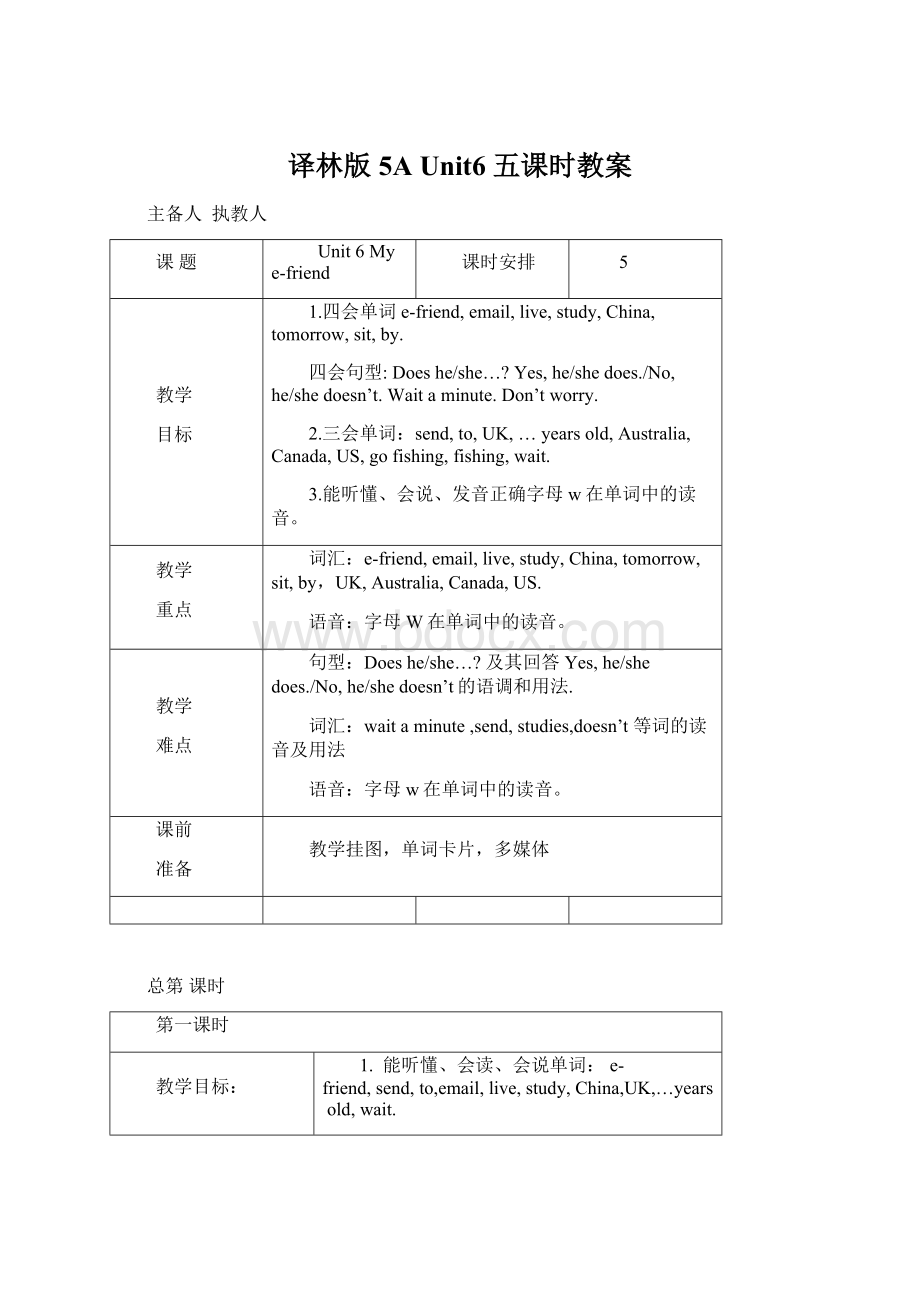译林版5A Unit6 五课时教案.docx
《译林版5A Unit6 五课时教案.docx》由会员分享,可在线阅读,更多相关《译林版5A Unit6 五课时教案.docx(15页珍藏版)》请在冰豆网上搜索。

译林版5AUnit6五课时教案
主备人执教人
课题
Unit6Mye-friend
课时安排
5
教学
目标
1.四会单词e-friend,email,live,study,China,tomorrow,sit,by.
四会句型:
Doeshe/she…?
Yes,he/shedoes./No,he/shedoesn’t.Waitaminute.Don’tworry.
2.三会单词:
send,to,UK,…yearsold,Australia,Canada,US,gofishing,fishing,wait.
3.能听懂、会说、发音正确字母w在单词中的读音。
教学
重点
词汇:
e-friend,email,live,study,China,tomorrow,sit,by,UK,Australia,Canada,US.
语音:
字母W在单词中的读音。
教学
难点
句型:
Doeshe/she…?
及其回答Yes,he/shedoes./No,he/shedoesn’t的语调和用法.
词汇:
waitaminute,send,studies,doesn’t等词的读音及用法
语音:
字母w在单词中的读音。
课前
准备
教学挂图,单词卡片,多媒体
总第课时
第一课时
教学目标:
1.能听懂、会读、会说单词:
e-friend, send, to,email, live, study, China,UK,…years old, wait.
2.能听懂、会读、会说日常用语:
Does he/she…?
Yes, he/she does. No, he/she doesn’t. Wait a minute.
3.能正确的理解并朗读课文,在教师的引导和帮助下尝试复述课文内容。
能初步运用本课所学的词汇和句型对自己的朋友或者网友进行综合全面的介绍
教学重点:
1.能正确理解并朗读课文,在教师的帮助下尝试复述课文。
2.能初步运用本课所学的词汇和句型对自己的朋友或者网友进行综合全面的介绍
教学难点:
运用本课所学的词汇和句型对自己的朋友或者网友进行综合全面的介绍
教学过程:
师生活动
思考与调整
【课前先学】
1.单词表和字典,写出以下单词的中文意思,并跟着磁带
读一读:
Australia ________ Canada ________
Cnina________ UK________ wait a minute ________
e-friend ________ send ________ email ________
2. 仔细阅读课文内容,根据课文内容填写下列表格。
Step 1. Preparation
1. Greeting.
2. Enjoy a song „Friends‟.
3. Free talk and review some words.
Do you have any friends?
What‟s your friend‟s name?
(板书name)
How old is he/she?
(板书age)
Where does he live?
(板书city)
Can he/she speak English?
(板书language)
What subjects does your friend like?
(板书subject)
What does your friend like doing?
(板书hobby)
Step 2. Presentation & Practice Pre-reading
1. T:
I like making friends.
I have many e-friends(板书e-friend)
and I often chat with them by qq on the Internet.
Look at the word, now do you know the meaning
of this word?
how to read?
Yes, today we will learn Unit 6 My e-friend.
2. Talk about e-friends with them
T:
Boys and girls, do you have qq numbers?
How many e-friends do you have?
T:
If I want to know some information about your
e-friend,how can I ask?
Can you give me some suggestion?
S:
..
T:
(师边指黑板边总结)
Yes ,you may say “What‟s your e-friend‟s name?
How old is he/she?
Where does he live?
”and so on.
3.Ask and answer
T:
Boys and girls, please take out your friend „
shoto and talk with your deskmates .
If you don‟t know how to ask ,you can open your
books and turn to page 66 Ask and answer.
4.T:
Look, who is he ?
(出示Wang Bing图片)
S:
He‟s Wang Bing.
T:
He has an e-friend too.
Who is his e-friend?
Please read by yourselves
and answerme some questions.
While-reading
1. Read the text and underline
Q:
How many questions does Liu Tao ask ?
What are they?
Please open your books and underline these
sentences.
2. Let’s check .
3. Watch the cartoon.
T:
This time,let’s watch the cartoon and
tell me the information about Peter.
4.T:
Wait a minute,there‟s something wrong on the
Internet. Let me have a look.
Teach the word:
Wait a minute
5.Check the answer
Step3 Production.
1.Read the story.
1) Read after the tape.
2) Read in roles.
2. Try to retell the story
T:
Now children. Turn to page 60.
Discuss in your group, and try to retell the story.
Step4 Progress.
After-reading 1.Think and write
T:
Can you write?
OK, Please try.
2. Listen and tick
T:
Turn to page 66, let’s do the exercise.
Homework:
1. Read the story.
2. Try to tell this story to your friend.
3.Read more English stories after school.
总第课时
第二课时
教学目标:
1.复习巩固本单元所学的词汇、句型。
2. 进一步熟悉一般现在时的一般疑问句及其肯定和否定回答。
3. 能掌握句型What subjects do / does …like?
的单复数形式。
4. 了解本单元新出现的动词的第三人称单数形式。
教学重点:
1. Learn the vocabulary:
Australia, Canada, China, UK, USlive-lives, study-studies.
2. Learn the third person singular in the sentences
教学难点:
能掌握句型What subjects do / does …like?
的单复数形式
教学过程:
师生活动
思考与调整
A. Warming up
1. Greetings
2. Free talk
T:
Who’s your friend?
S1:
…is my friend.…
T:
How old is he / she?
S1:
He / She is … years old.
T:
Where does he / she live?
S1:
He / She lives in „
T:
What subjects does he / she like?
S1:
He / She likes „
T:
What does he / she like doing after school?
…
3.学生拿出制作的朋友信息卡,在小组内交流、介绍。
B. Revision
1. 快速出示目标词汇卡片,学生认读
2. 播放Story time部分动画,学生配音
3. 完成教材P60 Think and write, 引导学生用完整的句子回答问题 。
1)师生问答
2)学生独立完成,教师巡视检查。
4. 引导学生根据教材P60 Think and say 提示,描述Peter的情况。
C. Grammar time
1. 读句子,认知句型
1)学生两人一组,朗读两组表格中呈现的句子,一人读问句,一人读答句。
2)引导学生观察并说说一般现在时的一般疑问句及其肯定和否定回答的构成规律。
3)引导学生归纳句型What subjects do / does …like?
的单复数形式。
2. 师生问答,操练关键词
教师任意说出表格中 的一般疑问句,学生给出肯定或否定的回答。
如:
T:
Does he have Chinese lessons at school?
Ss:
No, he doesn’t.
T:
Do they like swimming?
Ss:
Yes, they do.
3. 学生两人问答,就家人的年龄、业余爱好和职业等用第三人称的一般疑问句进行问答。
如:
S1:
How old is your mother?
S2:
She’s thirty-five.
S1:
Does she work?
S2:
Yes, she does.
S1:
Does she like drawing?
S2:
No, she doesn’t…
4. 引导学生再读Story time课文,划出动词的第三人称单数形式。
Live—live